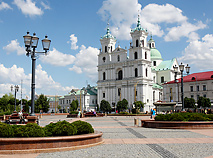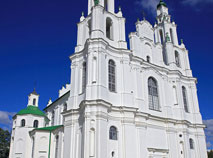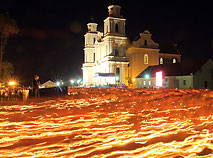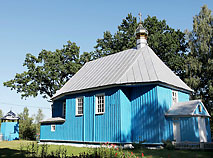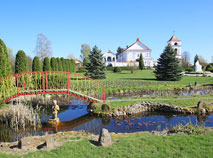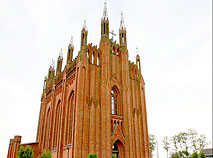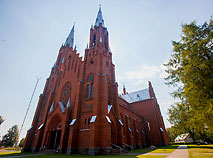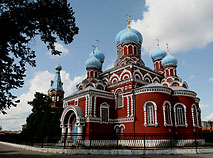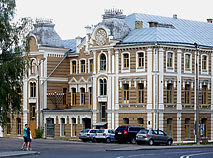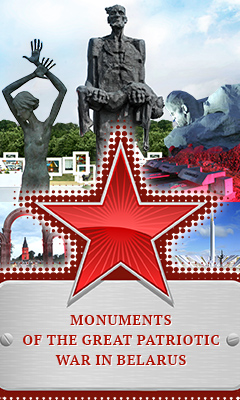Religious Tourism in Belarus
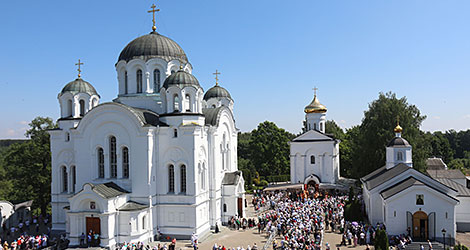
St. Euphrosyne Monastery in Polotsk
Belarus is located at the crossroads of cultures and faiths, therefore here you can find numerous ancient churches, convents and monasteries, synagogues, mosques, wooden temples of Old Believers…
A number of religions and architectural styles have intertwined in Belarus to give rise to a unique architectural style that you will not find anywhere else. Indeed, many local temples are one of a kind. Some of them have been nominated for the UNESCO World Heritage List:
-
Holy Transfiguration Church of Our Savior and St. Sophia Cathedral in Polotsk;
-
St. Nicholas Convent in Mogilev;
-
Fortified religious buildings: St. John the Baptist Catholic Church in the village of Kamai, Postavy District, the fortified Nativity of the Blessed Virgin Mary Orthodox Church in the village of Murovanka, Shchuchin District, St. Michael Church in the village of Synkovichi, Zelva District;
-
Wooden churches of Polesye.
Pilgrims from around the world and numerous tourists interested in history and architecture, come to Belarus to see magnificent churches and ancient halidoms of Belarus and to attend religious feasts and festivals.
Grodno is home to Belarus’ only museum of religion. The museum is housed in a former palace, a remarkable architectural specimen built in the Baroque and Classicism styles in the 18th-19th centuries. Its extensive exposition displays archaic beliefs, Christianity, Islam and Judaism…
Orthodox churches and halidoms
While travelling across Belarus, you will certainly see magnificent Orthodox churches, monasteries and convents having many centuries of history.
St. Euphrosyne, the holy patroness of Belarus, founded the Convent of Our Savior and St. Euphrosyne in the ancient town of Polotsk. Polotsk is also home to one of Belarus’ most ancient churches – the Holy Transfiguration Church which walls are decorated by unique frescos dating back to the 12th century.
Every year thousands of pilgrims flock to Polotsk to mark the St. Euphrosyne Day on 5 June. Her relics and the copy of the lost St. Euphrosyne Cross, one of the Belarusian halidoms, are kept in the Holy Transfiguration Church.
Another architectural gem of Polotsk – St. Sophia Cathedral – was built in the 11th century following the construction of similar churches in Kiev and Novgorod.
Belarus’ oldest operating church – Sts. Boris and Gleb Church (Kolozha Church) – was built on a steep bank of the Neman River in Grodno in the 12th century.
Other famous Orthodox temples in Belarus include:
-
Holy Ghost Cathedral Church, Sts. Peter and Paul Cathedral, the Protection of the Most Holy Mother of God Church in Minsk;
-
Holy Assumption Cathedral Church and the holy Resurrection Church in Vitebsk;
-
Sts. Boris and Gleb Church and the Exaltation of the Holy Cross Orthodox Cathedral in Mogilev;
-
St. Simon Cathedral Church and St. Nicholas Garrison Church in Brest;
-
Sts. Peter and Paul Cathedral in Gomel;
One of the points of interest of Minsk is the Memorial Church of All Saints and Innocent Victims in the Motherland, built in 2006-2008.
The Polesye town of Turov is the second oldest (after Polotsk) religious and spiritual center of Belarus. There you can see the wooden All Saints Church and the iconic stone crosses, fragments of a 12th-century temple. A monument "Script" in the Byzantine style was built in its place.
Unique wooden churches dating back to the 16th and 17th centuries survive in the Belarusian Polesye. They are famous for their remarkable architecture and unusual crosses. There are no two alike among them. For example, among them is the church in the village of Zditovo, Zhabinka District (built in the early 16th century), the church in Dobroslavka, Pinsk District (the smallest of churches: 5-7 meter wide)...
Famous monasteries of Belarus have become pilgrimage centers and attractions for tourists:
-
Holy Dormition Monastery in Zhirovichy, the country's largest Orthodox monastery, which houses one of the main Christian shrines of Belarus - the wonder-working Icon of the Mother of God of Zhirovichy;
-
Monastery of Our Savior and St. Euphrosyne in Polotsk;
-
St. Nicholas Convent in Mogilev;
-
Holy Assumption Hermitage Monastery of Mstislavl;
-
Convent of the Nativity of the Mother of God in Grodno;
-
Holy Theophany Kuteinsky Monastery in Orsha;
-
Holy Spirit Monastery in Vitebsk;
-
Yurovichi Monastery of the Nativity of the Mother of God (Kalinkovichi District);
-
Khmelyovo Holy Transfiguration Monastery (Brest District)...
There are many monuments to saints and outstanding religious personalities in Belarus:
-
St. Euphrosyne of Polotsk;
-
St. Elisha of Lauryshava in Novogrudok;
-
St. Sophia of Slutsk in Slutsk and Minsk;
-
St. Athanasius of Brest;
-
Sts. Peter and Fevronia of Murom in the village of Sarya, Verkhnedvinsk District;
-
St. Sergius of Radonezh in Minsk;
-
Patriarch of Moscow and All Russia Alexy II in Minsk and Vitebsk.
One of the Polotsk landmarks is the monument to architect John, the founder of the Polotsk architectural school. In the 12th century he built a church of the Transfiguration of the Savior by order of St. Euphrosyne.
Roman Catholic churches and relics
Being at the junction of the Orthodox and Roman Catholic worlds, Belarus has become a country where temples of two Christian faiths exist peacefully side by side.
Thanks to the historical events and the Church Union, Belarus has a unique blend of architectural styles. In Belarus you can often see Orthodox temples similar to Roman Catholic churches.
One of the examples is St. Sophia Cathedral in Polotsk. It was rebuilt in the 18th century on the ancient foundation as a basilica in the Vilno Baroque architectural style. Another example is the neo-Gothic church in the village or Sarya, Verkhnedvinsk District.
In the 17th -18th centuries amazing ensembles of Catholic churches and monasteries in the Baroque, Gothic and neo-Gothic styles were built in Belarusian cities and towns. They became real architectural gems of the country, places of worship.
Among famous Roman Catholic churches of Belarus are:
-
St. Francis Xavier Cathedral in Grodno – Farny Church (the church has the highest wooden altar decorated by more than 20 apostles and saints. One of its towers boasts Europe’s oldest clock);
-
Cathedral Church in Nesvizh;
-
St. Stanislaus Church in Mogilev;
-
Holy Trinity Church in the village of Gervyaty (Ostrovets District);
-
St. Anne Church in the village of Mosar (Glubokoye District);
-
Church of the Holy Transfiguration of Jesus Christ in Novogrudok;
-
Church of the Nativity of the Blessed Virgin in the village of Vidzy (Braslav District);
-
St. Andrew the First Called Church in the village of Naroch (Myadel District);
-
Trinity Church in Glubokoye;
-
St. John the Baptist Church in Golshany (Oshmyany District);
-
Sts. Peter and Paul Church in Zhuprany (Oshmyany District);
-
Archangel Michael Church in Ivenets (Volozhin District);
-
Trinity Church in Chernavchitsy (Brest District);
-
Most Holy Trinity Church in the village of Volchin (Kamenets District);
-
Church of Sts. Simeon and Elena (Red Church) in Minsk;
-
Holy Trinity Church (Saint Roch) in Minsk;
-
Cathedral of Saint Virgin Mary in Minsk.
A memorial cross was erected in Grodno at the site of the city’s biggest ancient temple – Vitaut Fara.
Every July thousands of pilgrims from Belarus and abroad flock to the village of Budslav, Myadel District, to visit the National Sanctuary which keeps one of Belarus’ main Catholic relics – the Budslav Icon of the Mother of God. Its 400th anniversary was celebrated in 2013.
Budslav also has a wonderful Baroque-style Church of the Ascension of the Blessed Virgin Mary and St. Barbara Chapel (1643) with a unique wooden altar. Pope John Paul II gave the church the title of a minor basilica in 1994 in recognition of its special role in the history and spiritual life.
Numerous pilgrims visit other Belarusian sanctuaries that keep wonderworking icons blessed by the Pope of Rome:
-
Mother of God of Trokeli (the village of Trokeli, Voronovo District hosts big annual pilgrimages);
-
Mother of God (Queen of Polesye) in Logishin (Pinsk District);
-
Mother of God in Gudogai (Ostrovets District);
-
Congregational Mother of God (Virgin Mary for Students) in Grodno;
-
Mother of God of Brest (Mother the Rescuer), which is a replica of the Mother of God image from the Rome basilica Santa Maria Maggiore;
-
Mother of God (Queen of Lakes) in Braslav.
Sanctuaries of other denominations
The only operating Protestant Church in Belarus is one of Grodno landmarks.
The Belarusian city of Vetka is a place of Old Believers. The ancient town boasts its Museum of Old Beliefs and Belarusian Traditions full of unique rarities.
In Gomel there is an acting church in honor of St. Prophet Ilya, owned by the Russian Orthodox Old Belief Church. St. Prophet Ilya Church is a specimen of the wooden architecture of the late 18th century.
Mosques in Belarus
In the time of the Grand Duchy of Lithuania there were over 100 mosques virtually in all Tatar settlements in Belarus. There were about 40 mosques at the beginning of the 20th century. However, after the Great Patriotic War there was only one functional mosque built in the town of Ivye, Grodno Oblast, in 1882.
In 2012 a unique monument to honor friendship between four religious denominations was unveiled in multi-national Ivye where Muslims and Jews, Catholic and Orthodox believers have been living peacefully for centuries.
As of today there are over 10 mosques and preaching houses in Belarus. Old wooden mosques were preserved in Novogrudok and in the village of Lovchitsy near the town.
A new magnificent mosque was built in Minsk in place of Belarus’ only stone mosque.
Synagogues in Belarus
Over 100 buildings of former synagogues were preserved in Belarus. However, many of them house various cultural and sports institutions, for example, the National Drama Theater and the House of Nature (Trinity Suburb) in Minsk, the Belarus Cinema in Brest…
A number of old synagogues that are monuments of history and architecture have been conserved or are renovated. Among them are, for example, a unique defensive synagogue in Bykhov, a synagogue complex in Ruzhany, a synagogue in Slonim (1642) where original Jewish frescos were preserved…
At present there are eight functional synagogues in Belarus. Some of them are wonderful specimens of architecture:
-
Great Synagogue of Grodno (1578) is one of the oldest functional and one of the most beautiful synagogues in Europe. It also has a museum of Jewish history;
-
a synagogue in Bobruisk (the late 18th – early 19th centuries).
In 1806 the first in Eastern Europe yeshivah (an institution of higher learning where future rabbis from different countries studied) was opened in the town of Volozhin. Another yeshivah was opened in Mir in 1815. Old buildings of yeshivahs have survived till our time. They are great attractions for pilgrims and tourists.
Religious Festivals in Belarus
-
International Orthodox music festival Kolozhsky Blagovest
-
International festival of organ music Bells of Sophia in St. Sophia Cathedral
-
Religious and educational exhibition fair Pokrovsky Kirmash
-
Minsk Orthodox Youth Ball
-
Orthodox youth festival Odigitriya in Vitebsk
-
Orthodox festival in Gomel
-
Orthodox youth festival of the Minsk diocese
-
Youth festival and exhibition Easter Cake
-
International festival of church music Magutny Bozha
-
International Catholic festival of Christian films and TV programs Magnificat
-
Catholic festival to honor the miraculous Budslav Icon (Budslav Fest)
In June 2014 Belarus hosted the 4th Orthodox- Catholic Forum.








 print version
print version make home page
make home page add to bookmarks
add to bookmarks